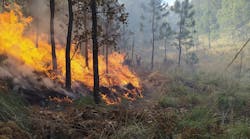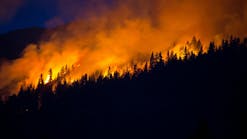The history and prevalence of wildland fires have never been more timely topics than they are today. These fires — which can ignite because of lightning strikes, human error and escaped prescribed burns — now number in the tens of thousands across the country each year. According to February 2022 data from theNational Interagency Fire Center (NIFC), 2021 saw nearly 59,000 wildfires burn more than 7.1 million acres (2.8 million hectares), and 2020 saw the highest number of acres burned — 10.1 million (4.1 million hectares) — over the preceding five-year period.
A common misconception with wildland fires is they primarily occur in the western half of the U.S., with the greatest concentration in California. While that region has indeed seen many significant and damaging fires, they are by no means limited to that area. Recent years have seen large wildland fires in Colorado, Oklahoma and other states. This is not a new trend, either. Research from the U.S. Department of Agriculture in December 2000 on the historical reach of wildland and prairie fires revealed virtually every part of the nation saw some type of fire-related incident during the pre-Columbian era. These included low-intensity understory fires, mixed-severity fires and larger stand replacement fires — those started intentionally by Indigenous tribes and those that started from a natural incident, such as a lightning strike.
What this data tells us is, with the right conditions, these fires can still occur today — and they do. According to the NIFC, as of Feb. 11, 2022, the total number of wildfires that have been contained stands at 3120 — up dramatically from 1758 in 2020 and 1516 in 2019 (note the NIFC updates this report weekly, so figures will change over time). Many of these fires have occurred in states in different parts of the country far from the West Coast, such as Florida and Texas. In prior years, fires in Alaska, Florida, Kentucky and Oklahoma also saw numerous incidents.
Because of the dynamic nature of fires across the U.S., it is critical utilities and their industry partners have a living fire plan. The term living is used because such a plan is not simply written and put on a shelf. It is revisited and revised on a consistent basis to ensure timeliness and accuracy. While organizations operating heavily on the West Coast will have extensive plans in place because of the prevalence of wildland fires and industry regulations, the continued growth and risk of wildland fires across the country means every organization, from utilities to tree care companies, must be prepared with a plan to keep employees and customers safe.
Purpose And Scope
Just as with any formal organizational policy or strategy, a living fire plan must first define its purpose and scope. It should clearly state who the plan has been created for, why the plan was created, what the plan includes at a high level and what the intended outcome of its use is. This information should be at the beginning of the plan and clearly called out, as it provides focus and clarity for team members as well as contractors and vendors with whom a utility is partnering. It also helps to establish what the document is about for industry regulators and compliance professionals.
Another key component that should be included immediately after the purpose and scope is a clarifying section about what employees and contractors are expected to do in the event of a fire. This is not the place for in-depth process-related details. Instead, this section should spell out at a high level what the employee and contractor responsibilities are, who should be contacted, in what order that communication should occur, and whether they should take action to address the ignition or instead focus on getting themselves to safety. It is essential to include these parameters up front, so employees and contractors understand what their first step is in a fire-related incident — and that personal safety is prioritized above all else.
Equipment List
It is imperative the plan defines and lists the equipment that field employees should have available in their vehicles as they visit and work on jobsites throughout their territory. This ensures employees and contractors understand what fire suppression equipment they should always have with them and can verify they have it before driving to a job site. Examples include fire extinguishers, safety cones, first-aid kits, water packs and tools such as shovels and fire rakes.
The primary focus of these tools in fire mitigation is to enable employees and contractors to extinguish an ignition caused by their vehicle. Running vehicles present opportunities for hot material, such as metal parts and muffler exhaust, to come into contact with grasses and other flammable elements on a job site. Combustion engine equipment being used nearby, such as wood chippers and saws, also are potential ignition points. Defining the fire suppression equipment employees should have, in conjunction with training on its use, is key to avoiding situations that could cause an ignition and educating employees on rapid mitigation.
Clear Expectations
For utilities with contractors and vendors working on their behalf throughout their territory, it is essential those partners be the best stewards of the land and assets as possible. Should an incident occur, ensuring they follow clearly defined processes and steps to address the incident helps to maximize job site safety and prevent a fire from spreading. First and foremost, the personal safety of employees and contractors should be prioritized. This means the plan should define when personnel are expected to act themselves vs. leaving an incident to safety professionals.
It also should clearly spell out communication best practices. Personnel should be encouraged to raise the alarm if they see something happening that could lead to an ignition. Taking that one moment to reassess a situation or action could prevent an ignition and avoid damage or injury. The plan also should specify which authorities and parties should be contacted, in what time frame and in what order. As always, job site personnel should always call 9-1-1 first in the event of an incident, followed by any responsible leaders at their organization or the utility.
Pre-, during and post-fire efforts should be defined. For example, if an ignition results in downed power lines, this presents additional safety concerns. The plan should communicate what is expected of employees and contractors if lines come down or mitigation efforts bring them into an area with downed lines. Another example of a post-fire event activity is working in recently burned landscapes. When vegetation has burned off, workers may encounter previously unpredicted hazards, such as the navigation of burned-out stump holes and unstable grades. Working in an area where these hazards are present requires additional safety precautions that must be left to trained professionals or require more formal training for employees.
Additionally, the plan should communicate the importance of team members informing supervisors where they will be at all times. Much of this likely will be known already before dispatching a crew to a job site, but if a situation arises in which a field employee must relocate during the day, that should be communicated early so supervisors are aware along with the reason for the relocation. Personnel should check in with supervisors frequently, as well.
The plan should provide methods and best practices for fire prevention, suppression and reporting around fire-related incidents. Examples include information on direct and indirect attack methods; best management practices that support preventive actions and using required resources during designated fire seasons; and having vehicles inspected and limiting their use during high fire adjective ratings. If an ignition does occur, the plan should detail what information personnel are expected to provide when they report the incident to superiors.
A final consideration is including information on the various training activities, materials and processes used to educate personnel on fire prevention, mitigation and safety. Every training and educational resource should be included to demonstrate the utility’s commitment to keeping people informed. Examples include listing fire-related safety tailboards, documents, manuals, auditing checklists and other related materials.
Keeping The Plan Alive
Finally, a fire plan must detail the method and frequency by which it will be reviewed and updated by responsible parties. Codifying this ensures utilities and their partners maintain consistent review cycles. Oftentimes, new equipment needs, technology updates and changes, and shifts in where businesses operate will require additions to the plan or revisions to existing sections. When changes are made, they must be communicated to personnel in safety training, tailboard meetings and other appropriate events as well as across other communication mediums.
Those new to implementing a fire plan should consider conducting reviews biannually. Plan elements pertaining to summer months should be reviewed well ahead of time in the preceding winter months, and winter-related plans should be reviewed during the summer. This ensures ample time for changes to be drafted, finalized, communicated and tested. Examples include reviewing the summer components of the plan as they pertain to heat, wildlife populations and dry vegetation. Winter-related examples include driving or working during inclement weather, winter storm response and limited daylight.
Prioritize A Fire Plan
As awareness around wildland fires continues to grow, it is imperative utilities and the organizations partnering with them for vegetation management and other field services carefully consider their fire plans to ensure they clarify, educate and protect people, environments and assets. Everyone is stewards of the land they manage and work on, and a living fire plan is one of the best ways to ensure it continues to thrive for years to come.
Bob Urban ([email protected]), ACRT Services senior manager, has more than 25 years of experience in the utility services industry. He has built a wealth of expertise on everything from operations and sales to training and negotiation. He is an ISA-Certified Utility Arborist and a graduate of Paul Smith’s College in New York.


